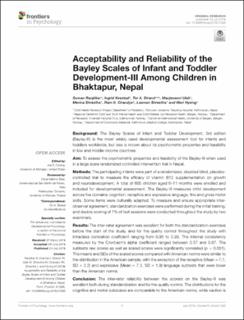| dc.contributor.author | Ranjitkar, Suman | |
| dc.contributor.author | Kvestad, Ingrid | |
| dc.contributor.author | Strand, Tor Arne | |
| dc.contributor.author | Manjeswori, Ulak | |
| dc.contributor.author | Shrestha, M | |
| dc.contributor.author | Chandyo, Ram K | |
| dc.contributor.author | Shrestha, Laxman | |
| dc.contributor.author | Hysing, Mari | |
| dc.coverage.spatial | Norway | en_US |
| dc.date.accessioned | 2020-03-06T12:35:25Z | |
| dc.date.available | 2020-03-06T12:35:25Z | |
| dc.date.issued | 2018 | |
| dc.identifier.issn | 1664-1078 | |
| dc.identifier.uri | https://hdl.handle.net/11250/2645812 | |
| dc.description.abstract | Abstract
Background: The Bayley Scales of Infant and Toddler Development, 3rd edition (Bayley-III) is the most widely used developmental assessment tool for infants and toddlers worldwide, but less is known about its psychometric properties and feasibility in low and middle-income countries. Aim: To assess the psychometric properties and feasibility of the Bayley-III when used in a large scale randomized controlled intervention trial in Nepal. Methods: The participating infants were part of a randomized, doubled blind, placebo-controlled trial to measure the efficacy of vitamin B12 supplementation on growth and neurodevelopment. A total of 600 children aged 6-11 months were enrolled and included for developmental assessment. The Bayley-III measures child development across five domains: cognition, receptive and expressive language, fine and gross motor skills. Some items were culturally adapted. To measure and ensure appropriate inter-observer agreement, standardization exercises were performed during the initial training, and double scoring of 7% of test sessions were conducted throughout the study by two examiners. Results: The inter-rater agreement was excellent for both the standardization exercises before the start of the study, and for the quality control throughout the study with intraclass correlation coefficient ranging from 0.95 to 0.99. The internal consistency measured by the Cronbach's alpha coefficient ranged between 0.57 and 0.87. The subtests raw scores as well as scaled scores were significantly correlated (p < 0.001). The means and SDs of the scaled scores compared with American norms were similar to the distribution in the American sample, with the exception of the receptive (Mean = 7.7, SD = 2.2) and expressive (Mean = 7.3, SD = 1.9) language subtests that were lower than the American norms. Conclusion: The inter-rater reliability between the scorers on the Bayley-III was excellent both during standardization and for the quality control. The distributions for the cognitive and motor subscales are comparable to the American norms, while caution is needed in the interpretation of the language scales. The results suggest that Bayley-III is a feasible tool for the assessment of neurodevelopmental status in nutritional studies in low resource settings such as Nepal. Cultural adaptations, training and standardization are prerequisites for a valid and reliable assessment using the Bayley-III. | en_US |
| dc.description.sponsorship | This work has been supported by the Thrasher Research fund (award 11512) and GC Rieber funds. | en_US |
| dc.language.iso | eng | en_US |
| dc.rights | Navngivelse-Ikkekommersiell-DelPåSammeVilkår 4.0 Internasjonal | * |
| dc.rights.uri | http://creativecommons.org/licenses/by-nc-sa/4.0/deed.no | * |
| dc.subject | Bayley scales of infant and toddler development-III; | en_US |
| dc.subject | LMIC; | en_US |
| dc.subject | neurodevelopment; | en_US |
| dc.subject | psychometric properties; | en_US |
| dc.subject | reliability | en_US |
| dc.title | Acceptability and Reliability of the Bayley Scales of Infant and Toddler Development-III Among Children in Bhaktapur, Nepal | en_US |
| dc.type | Peer reviewed | en_US |
| dc.type | Journal article | en_US |
| dc.description.version | publishedVersion | en_US |
| dc.rights.holder | © 2018 Ranjitkar, Kvestad, Strand, Ulak, Shrestha, Chandyo, Shrestha and Hysing. This is an open-access article distributed under the terms of the Creative Commons Attribution License (CC BY). The use, distribution or reproduction in other forums is permitted, provided the original author(s) and the copyright owner(s) are credited and that the original publication in this journal is cited, in accordance with accepted academic practice. No use, distribution or reproduction is permitted which does not comply with these terms. | en_US |
| dc.subject.nsi | Medisin og helsefag | en_US |
| dc.source.pagenumber | 10 | en_US |
| dc.source.volume | 9 | en_US |
| dc.source.journal | Frontiers Psychology | en_US |
| dc.source.issue | 1265 | en_US |

